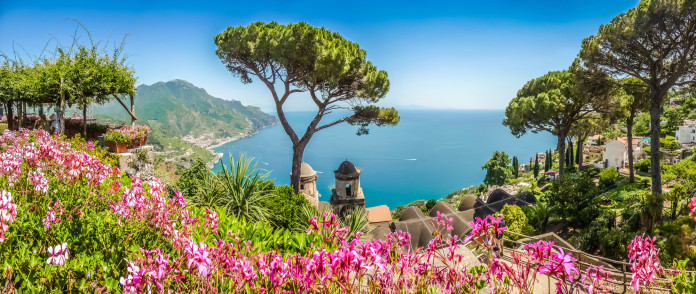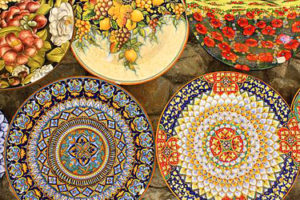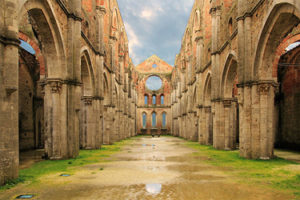The Cinque Terre (Five Lands) is a portion of the Ligurian cliffs along Italy’s western coast. It consists of five villages: Riomaggiore, Manarola, Corniglia, Monterosso and Vernazza. They are the most uncontaminated and charming part of the region . The Cinque Terre have been a natural reserve since 1997 and they are included on the UNESCO’s world heritage list.
The coast could appear hostile because of the rugged and steep cliffs, but it is rich of charming bays, beaches and panoramic paths. The hinterland is made of beautiful medieval villages, sanctuaries, workshops and typical dishes. We want to suggest you 10 things to see and do in this beautiful coastline, in order to have an unforgettable holiday.
If you are looking for a hotel in the Cinque Terre, we suggest you to choose among those offered by Booking.com. There are about 150 hotels with prices, pictures and comments of guests already stayed there. Go to Booking.com
Riomaggiore - The Cinque Terre
1
The village of Riomaggiore rises between two steep cliffs. It looks like a nativity scene with all its little colored houses built in a vertical way. It’s suggestive to have a walk in these alleys, where lights and shadows create very particular effects.

The originality of Riomaggiore’s houses is due to the fact that each one has two entries: the front door on the alley and the back door on the upper street. The houses had this particular structure since 1500 to allow a fast escape in case of Saracen raids. In Riomaggiore starts the famous Via dell’Amore (Love Path): a paved path, dug into the rock, that ends in Manarola. The path is wonderful, you can walk into the wild and hear the sound of waves breaking on the rocks. Riomaggiore is a shy town, you’ll slowly discover the village, the Castello in Cerricò with its great sea view, and the church of San Giovanni Battista.
Manarola - The Cinque Terre
2
Manarola is a colorful painting and the reign of the olive trees. Its houses look like the natural prosecution of the narrow and long cliff. The name of this town probably comes from “Magna Rota”, literally “big wheel” of a water mill. In the lower city you can still see the old mill or oil mill, that was recently restored.

In the high part of the town there’s the church of San Lorenzo, built in 1338 in Gothic style, with three beautiful naves and baroque interiors. You can’t miss the Campanile Bianco, an ancient watchtower, the ancient San Rocco’s hospital and the Oratorio dei Disciplinati della Santissima Annunziata (oratory) dated back to 1400. The sea lovers definitely won’t be disappointed: going down into the beach direction you’ll find a lot of corner from which you’ll enjoy a breathtaking view.
Corniglia - The Cinque Terre
3
The ancient Roman village of Corniglia is placed on an impressive cliff about 100 meters high. It’s the only town in the Cinque Terre that can’t be reached by sea.

Therefore to reach Corniglia is necessary to climb the “Lardarina”, an exhausting brick stairway (the flight are 33 and the steps 377), or, if you prefer, you can follow the road that, from the station, leads to the village. The name of the town “Corniglia” comes from the name of a Latin farmer “Corneliu” who produced the white wine, already famous at Romans time. In the delightful village you could visit the Gothic church of San Pietro and the XVIII century square “Largo Taragio” with the Oratory of Santa Caterina. Corniglia is a precious jewel, made of alleys and little streets dug into the rock. It has also a beautiful beach called “Spiaggione” and a transparent and crystalline sea that you can’t miss.
Vernazza - The Cinque Terre
4
Vernazza is situated on an impressive cliff, nowadays is a calm seaside village but, in the past, it was the harbor of the boats in charge to protect the coasts from the Saracens.

The magical atmosphere of this village will seduce you: mysterious alleys, among the little red, yellow and pink houses in the summertime are crowded of tourists. Vernazza is considered one of the 100 most beautiful villages of Italy with its maritime vocation. We suggest you to reach this town by sea to see at once the beautiful harbor. You can visit also the church of Santa Margherita di Antiochia and the remains of the ancient fortress: the towers of the XI century and the Doria’s castle, the Monastery’s tower of Padri Riformati di San Francesco and the tower Belforte. The astonishing Sanctuary of Nostra Signora di Reggio isn’t easy to reach, you’ll have to walk through a wild road. Maybe it will be hard but it’s really worth it.
Monterosso - Cinque Terre
5
Monterosso al Mare is the place loved by Eugenio Montale: here the Italian writer, who won the Nobel prize in 1975, used to spend his summers.

Monterosso inspired some of its verses as: “Rocky stern town, asylum for fishermen and farmers.” This village maintains its maritime tradition and it still has signs of the past sea battles: the medieval tower that now is the bell tower of San Giovanni Church, the castle with its three round towers, and the Aurora tower, the only one survived of thirteen towers that protected the village. You can spend your time in the old town centre visiting the church of San Giovanni Battista, or you can stay in the modern Fegina with its beach . Moreover Monterosso’s beach is the biggest of the Cinque Terre.
The Via dell'Amore - The Love path - Cinque Terre
6
There are several natural paths in the Cinque Terre. One of the most famous in the world is the path that links Riomaggiore to Manarola.

The Via dell’Amore – Love Path – is part of the Blue Path that links all the villages of the Cinque Terre. In particular, this path of about 1 km is very charming, romantic, the easiest to pass through. It takes its name from the inscription that an anonymous resident wrote on a wall, at the beginning of the path on the side of Riomaggiore. He wrote that the path was the favorite place of lovers. So the municipalities decided to formalize the name, installing benches and works of art that evoke the theme of love. You have to pay to access to this path, but it’s always a crowded path. We suggest you to visit it in the early morning or in the evening.
The Sanctuaries path - Cinque Terre
7
Each town of the Cinque Terre has its own shrine suspended among the sea and the sky. These shrines form a kind of natural Via Crucis visited during sacred rites.

The main Sanctuaries of the Cinque Terre are five: Nostra Signora di Montenero in Riomaggiore, Nostra Signora delle Grazie in San Bernardino, in Corniglia, Nostra Signora della Salute in Manarola, Nostra Signora di Soviore, in Monterosso and Nostra Signora di Reggio, in Vernazza. The sanctuaries of Vernazza, Monterosso and Volastra are the most ancient ones, while the sanctuaries of Riomaggiore and Corniglia are the most recent ones. The street that brings in these places of worship it’s perfect for trekking lovers, with its tortuous streets, its beauty corners and its incredible panorama. From there, on a clear day, you can even see Corsica.
How to get to Cinque Terre
8
Reaching the Cinque Terre is quite simple in the summer, but a little less simple during winter: you can use boats, trains and buses to move from one village to another.

If you prefer the train, there are many routes on the line Pisa – Genova that allow you to reach all the towns of the Cinque Terre, but there are also several intercity trains with stops in Monterosso and Riomaggiore. Then there are some trains that leave from La Spezia and stop in all villages. Trains, especially in summer, are very frequent and they are quite cheap. If you prefer to enjoy the Cinque Terre by sea, during the spring and summer there are boats every day that leave from La Spezia, Porto Venere, Portofino and Lerici arriving in Monterosso, Riomaggiore, Vernazza and Monterosso al Mare. If you buy the Cinque Terre Card Battello you can enjoy not only the boats for travel, but you will also be able to access to all paths and the services offered by the Park. Even the buses are very useful to move among the many villages of the Cinque Terre and they are powered by natural gas. Bus schedules can vary from season to season and you have to request them at the reception centers of the towns of the Cinque Terre and La Spezia. If you can, you should avoid the car because parking in Cinque Terre is pretty much impossible.
Things to eat in Cinque Terre
9
The typical dishes of the Cinque Terre are very essential and simple. Cinque Terre main course is seafood: breams, anchovy, squids, anchovies, squid, sea bass, octopus and cuttlefish that you can it grilled, fried or roasted. They’re always delicious.

All the specialties are often enriched with aromatics herbs, such as: marjoram, oregano and thyme and olive oil. Cinque Terre’s important ingredients are vegetables too. For example you can eat a delicious minestrone soup prepared with Swiss chards, artichokes, cabbages, leeks and potatoes. We suggest you to drink the white wine, that is another typical product of the area, and at the end of your meal you should drink a glass of Sciachetrà, (it’s a wine “passito”, strong sweet wine made with raisins)
Where to sleep in Cinque Terre
10
It is not easy to find a place to sleep in the Cinque Terre. The big hotels don’t exist, there are mostly small hotels, apartments, guest houses and B&Bs.

You have to book in advance, of course, to find a place with the right price. In high season, ie during the spring and summer, if you don’t book in advance, you’ll find bad places with high prices
If you are looking for a hotel in the Cinque Terre, we suggest you to choose among those offered by Booking.com. There are about 150 hotels with prices, pictures and comments of guests already stayed there. Go to Booking.com






















